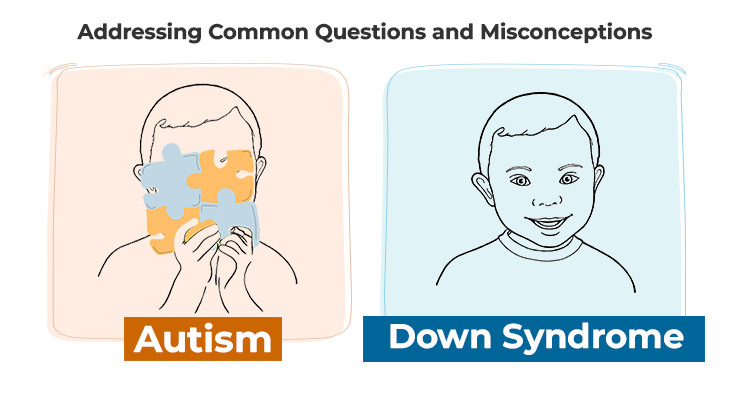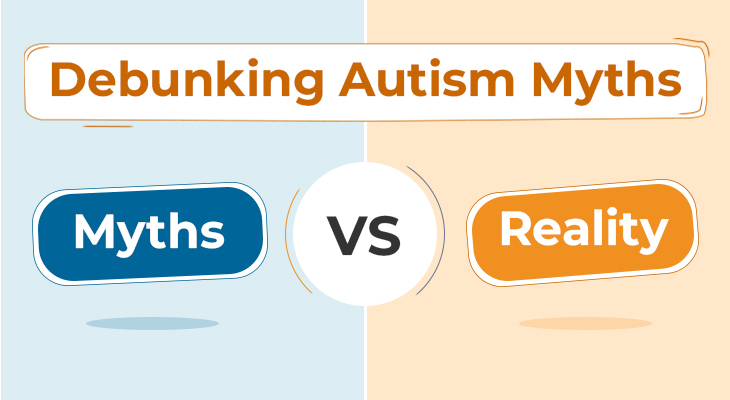Autism spectrum disorder (ASD) is a complex neurodevelopmental condition that affects how people communicate and interact with the world around them. It is a spectrum disorder, meaning that the range and severity of symptoms can vary widely from person to person.
The terms “low-functioning” and “high-functioning” autism are often used to describe the severity of a person’s symptoms. However, these terms can be misleading and stigmatizing. They can suggest that people with ASD are either capable of living independent lives or are incapable of doing so. This is not the case. All people with ASD are individuals with unique strengths and challenges, and their symptoms change over time. For example, a person who was diagnosed with “high-functioning” autism as a child may need more support as they get older. Conversely, a person who was diagnosed with “low-functioning” autism as a child may learn to manage their symptoms and live a more independent life as they get older.
Table of Contents
- What is low-functioning autism?
- Is low-functioning autism an official medical diagnosis?
- Why is low-functioning autism considered outdated and misleading?
- Is there a formal medical diagnosis that corresponds to the term “low-functioning autism”?
- What are the symptoms of low-functioning autism?
- What are the therapies for low-functioning autism?
- Does low-functioning autism mean low IQ?
- Does low-functioning autism get worse with age?
- Does low-functioning autism need special schooling?
- What are the most common comorbid conditions with severe autism?
- What is the Importance of early intervention for low-functioning autism?
- What are the strategies for managing challenging behaviors in individuals with low-functioning autism?
- What are the ways to support families and caregivers of individuals with low-functioning autism?
- References
What is low-functioning autism?
Low-functioning autism is a term used to describe individuals with ASD who have significant impairments in communication, social interaction, and behavior.
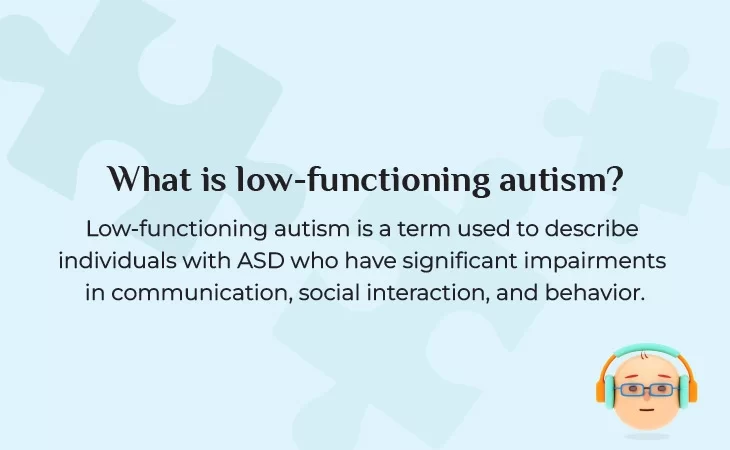
Download Download & share this Knowledge Card in your network [Free Download]
Is low-functioning autism an official medical diagnosis and is it considered a distinct subtype of ASD within the diagnostic framework?
The term “low-functioning autism” does not exist as an official medical diagnosis. The current diagnostic framework for autism spectrum disorder (ASD) in the Diagnostic and Statistical Manual of Mental Disorders, Fifth Edition (DSM-5) does not recognize “low-functioning autism” as a distinct subtype or level of severity.
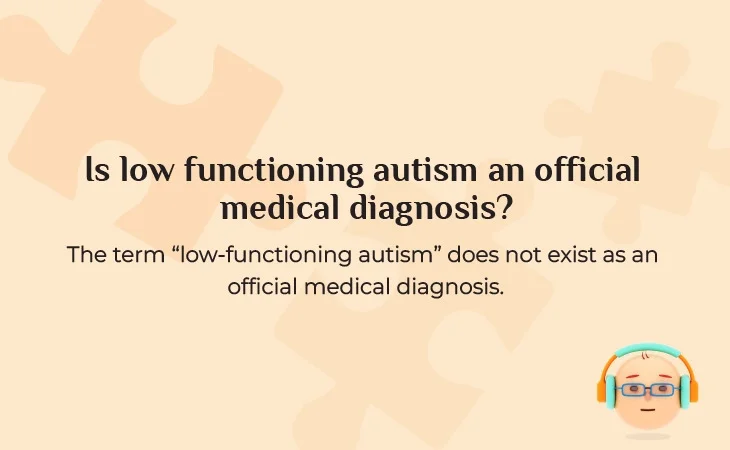
Download Download & share this Knowledge Card in your network [Free Download]
Why is low-functioning autism considered outdated and misleading?
Low-functioning autism is considered outdated and misleading because it can create a false dichotomy between individuals with mild and severe ASD, suggesting that those with “low-functioning” autism are incapable of independent living, which is not always the case.
The term low-functioning autism, along with the term high-functioning autism, fails to capture the full spectrum of abilities and challenges experienced by individuals with autism, and have potentially stigmatizing effects. These labels do not accurately reflect an individual’s intelligence, sensory sensitivities, emotional regulation, talents, or perseverance.
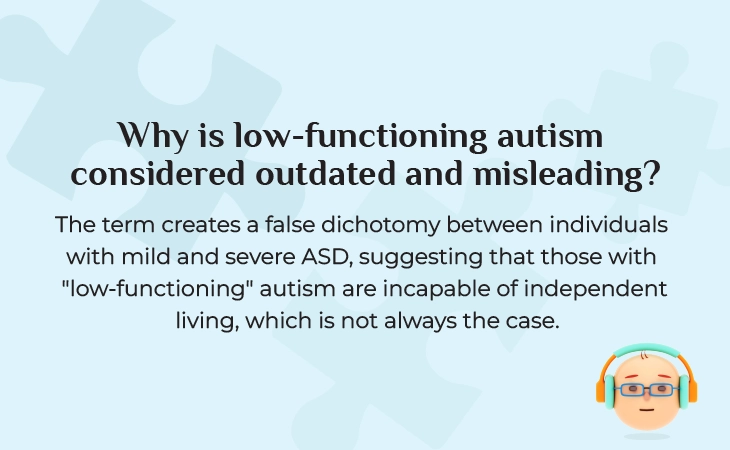
Download Download & share this Knowledge Card in your network [Free Download]
Is there a formal medical diagnosis that corresponds to the term "low-functioning autism"?
The DSM-5 recognizes three levels of severity for ASD, ranging from Level 1 (requiring the least support) to Level 3 (requiring the most support):
-
Autism level 1:
Individuals with level one of ASD have the mildest of symptoms which do not drastically interfere with their daily lives.
-
Autism level 2:
People with level two autism need some support in working on social skills as well as speech therapy.
-
Autism level 3:
Level three of ASD is the most pronounced, and people with this type of autism will require a good deal of support, which might involve an around-the-clock aide or rigorous therapy.
Children and adults with low-functioning autism display the most severe symptoms of ASD and are most often diagnosed at level three. These individuals need support from a caretaker throughout life and are usually not able to live by themselves.
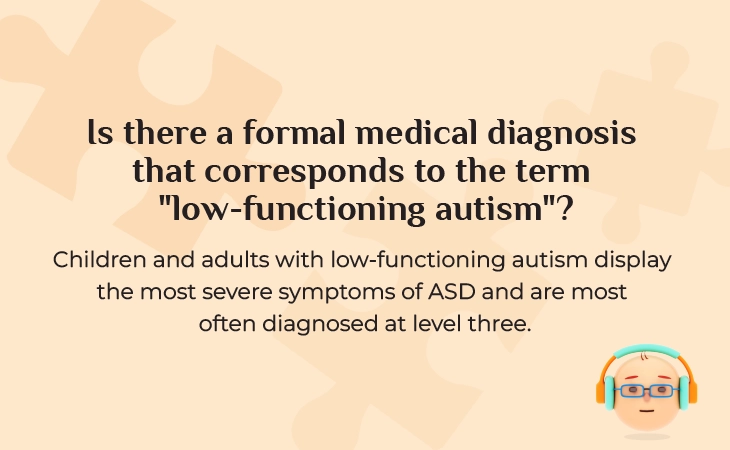
Download Download & share this Knowledge Card in your network [Free Download]
What are the symptoms of low-functioning autism?
Individuals with severe autism spectrum disorder (ASD) may exhibit significant challenges in social interaction, communication, and repetitive behaviors:
-
Severe deficit in language:
Lack the ability to effectively communicate using alternative methods like picture display boards or technological aids such as AAC (Augmentative and Alternative Communication) devices.
-
Sensory challenges:
People with low-functioning autism may seek out sensory experiences to self-regulate or find comfort, while others may find certain sensory inputs overwhelming or distressing:
- Individuals with heightened sensory sensitivities may display behaviors like covering their eyes or ears, emitting loud vocalizations, or attempting to escape from the environment to manage their sensory overload.
- Individuals with sensory under-stimulation may engage in repetitive behaviors, such as arm flapping or making mouth noises, to provide themselves with self-regulating sensory input.
-
Repetition:
Visual self-stimulation in individuals can manifest in behaviors such as rhythmic bodily movements like arm flapping or jumping, repeating spoken words or sounds (echolalia), or repetitive manipulation of objects to provide visual stimulation.
-
Behavioral problems:
Frequent tantrums, including those involving self-injurious behavior and incredibly resistant to changes in daily routines.
What are the therapies for low-functioning autism?
Tailored therapeutic interventions can play a crucial role in supporting the individual to become self-sufficient thus enhancing quality of life. Here’s an overview of some common therapeutic approaches for low-functioning autism:
-
Augmentative and Alternative Communication (AAC)
AAC encompasses a range of strategies and tools that empower low-functioning autistic individuals to communicate effectively, especially for those who face verbal communication difficulties. AAC interventions may incorporate sign language, Picture Exchange Communication System (PECS), or Speech-Generating Devices (SGDs) to facilitate their ability to express their thoughts, needs, and ideas.
-
Speech-language therapy
Speech-language therapy focuses on improving an individual’s oral and written communication skills. Therapists work closely with low-functioning autistic individuals to enhance their articulation, language comprehension, and social-pragmatic communication abilities. Through targeted interventions, individuals can develop more effective communication strategies to engage in meaningful interactions.
-
Occupational therapy
Occupational therapy aims to promote independence and participation in everyday activities. Therapists work with individuals to develop daily living skills, such as personal hygiene, dressing, and self-care routines. Occupational therapy also addresses sensory processing challenges by incorporating sensory-based interventions to help individuals adapt to their environment and manage sensory sensitivities.
-
Sensory integration therapy
Sensory integration therapy focuses on helping low-functioning autistic individuals to regulate their sensory processing system. Therapists provide sensory-based activities and interventions to help individuals modulate their responses to various sensory stimuli, such as touch, sound, and light. This approach can help individuals reduce sensory sensitivities, improve sensory organization, and enhance their ability to function in different environments.
-
Applied Behavioral Analysis (ABA)
ABA is a systematic and evidence-based approach that focuses on improving socially appropriate behaviors and reducing problematic behaviors. ABA therapists work closely with individuals and their families to develop individualized behavior intervention plans (BIPs) that target specific behaviors and skills. ABA interventions can help individuals enhance communication, social interaction, and play skills while reducing maladaptive behaviors such as self-injury or aggression.
It is important to note that these therapeutic approaches are not mutually exclusive and can be combined to create a comprehensive treatment plan tailored to the unique needs and challenges of each individual with ASD.
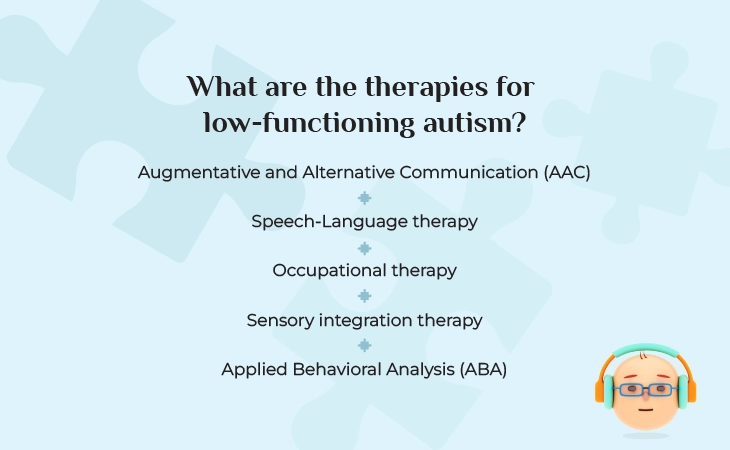
Download Download & share this Knowledge Card in your network [Free Download]
Does low-functioning autism mean low IQ?
Some individuals with low-functioning autism will show symptoms of an intellectual disability (ID)
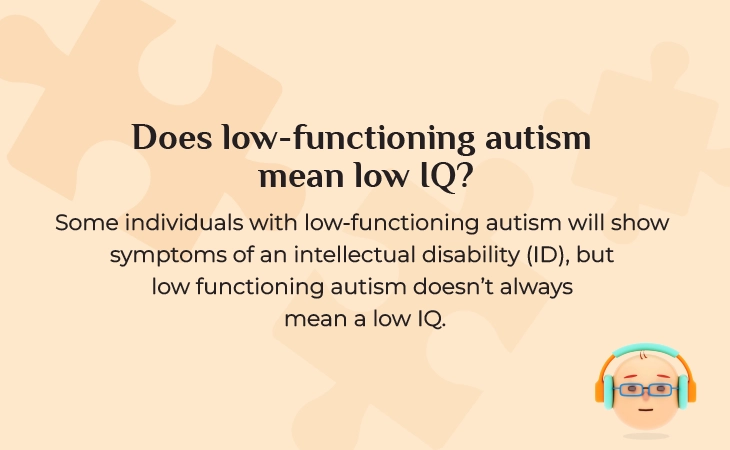
Download Download & share this Knowledge Card in your network [Free Download]
Does low-functioning autism get worse with age?
Researchers observed a correlation between age and symptom severity in autism, with symptoms in social situations, flexible thinking, and communication intensifying with age. [3]

Download Download & share this Knowledge Card in your network [Free Download]
Does low-functioning autism need special schooling?
Yes, individuals with low-functioning autism may benefit from specialized educational programs that are tailored to their unique needs and challenges. These programs should be developed collaboratively by professionals, family members, and the individual themselves through the individualized education program (IEP) process[2]. The IEP should outline specific strategies for:
- Enhancing communication: Providing alternative and augmentative communication (AAC) tools and techniques to support individuals who have difficulty with verbal communication.
- Teaching social skills: Incorporating social skills training and interventions to help individuals develop appropriate behaviors for various social situations.
- Addressing sensory sensitivities: Implementing sensory-based interventions and accommodations to help individuals manage sensory overload and promote sensory regulation.
While there is no distinction between low-functioning and high-functioning autism in the context of IEPs, each student’s IEP should reflect their specific needs and abilities. Specialized educational programs for individuals with low-functioning autism can play a crucial role in their overall development, enabling them to acquire essential skills, enhance their communication abilities, and participate in meaningful social interactions.

Download Download & share this Knowledge Card in your network [Free Download]
What are the most common comorbid conditions with severe autism?
Medical comorbidities are more common in children with autism spectrum disorders (ASD) than in the general population[1]. This is applicable for people across Level 1, Level 2 and Level 3 and not specifically for Level 3 autism.
- Skin allergies: People with autism are 1.6 times more likely to have eczema or skin allergies
- Asthma: People with autism are 1.8 times more likely to have asthma
- Food allergies: People with autism are 1.8 times more likely to have food allergies
- Ear infections: People with autism are 2.1 times more likely to have frequent ear infections
- Headaches: People with autism are 2.2 times more likely to have severe headaches
- Diarrhea or Colitis: People with autism are 3.5 times more likely to have diarrhea or colitis
- Gastrointestinal (GI) problems: People with autism are 7 times more likely to report gastrointestinal (GI) problems and occur in 46% to 84% of them.
- Sleep disorders are a significant problem in individuals with autism, occurring in about 80% of them.
- Genetic disorders: Some genetic disorders are more common in children with ASD such as:
- Fragile X syndrome
- Down syndrome
- Duchenne muscular dystrophy
- Neurofibromatosis type I
- Tuberous sclerosis complex
- Neurological disorders: Children with autism are also more prone to a variety of neurological disorders, including epilepsy, macrocephaly, hydrocephalus, cerebral palsy, migraine/headaches, congenital abnormalities of the nervous system
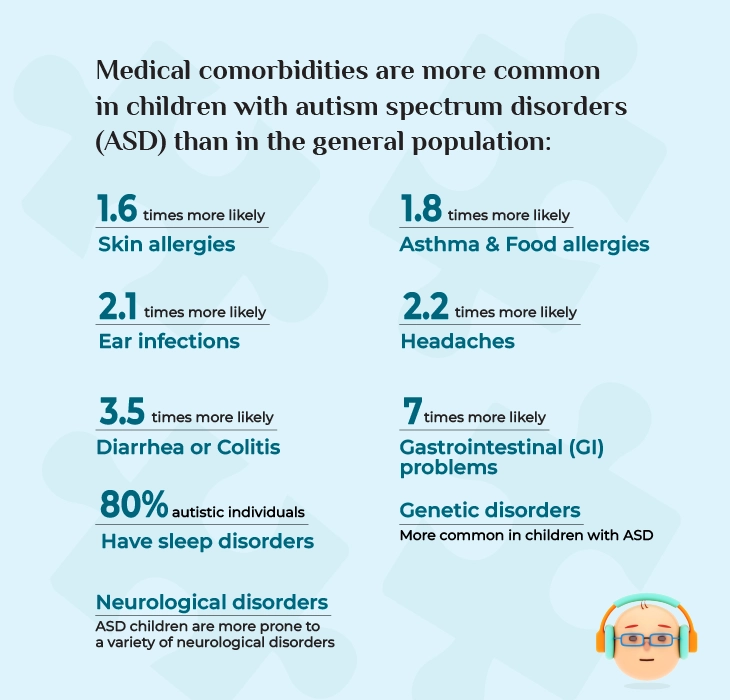
Download Download & share this Knowledge Card in your network [Free Download]
What is the importance of early intervention for low-functioning autism?
Early intervention is crucial for individuals with low-functioning autism, as research has demonstrated that timely support during the preschool years can lead to substantial improvements in communication, social interaction, and behavior.
Early intervention also empowers parents and caregivers to better comprehend their child’s strengths and challenges. It equips them with the necessary tools and strategies to foster their child’s development and enhance their quality of life.
While early intervention cannot eradicate autism, it can make a profound impact on an individual’s life. By providing early support, we can empower individuals with low-functioning autism to reach their full potential and lead fulfilling lives.

Download Download & share this Knowledge Card in your network [Free Download]
What are the strategies for Managing Challenging Behaviors in Individuals with Low-Functioning Autism?
Individuals with low-functioning autism may exhibit challenging behaviors that impact their daily lives and the lives of those around them. These behaviors, often stemming from communication difficulties or sensory overload, may include aggression, self-injury, or property destruction. It is crucial to recognize that these behaviors are not intentional and require appropriate management strategies. Strategies for managing challenging behaviors:
- Identify triggers
- Determine the specific stimuli or situations that trigger challenging behaviors. These triggers could include certain sounds, textures, or social interactions.
- Once triggers are identified, implement strategies to avoid or minimize exposure to them, creating a more predictable and comfortable environment.
- Use visual supports
- Leverage visual aids, such as schedules, social stories, and visual cues, to provide clear and consistent information about daily routines and expected behaviors.
- Visual supports can help individuals with low-functioning autism navigate their day more effectively, reducing anxiety and the likelihood of challenging behaviors
- Address sensory needs
- Sensory input can help low-functioning autistic individuals self-soothe and manage their emotions, reducing the likelihood of emotional outbursts or challenging behaviors.
- Provide opportunities for sensory regulation through activities like deep pressure massage, swinging, or jumping on a trampoline.
- Reinforce positive behavior
- Acknowledge and reward positive behaviors with praise, preferred activities, or tangible rewards.
- Immediate and consistent reinforcement encourages the repetition of desired behaviors and promotes a positive learning environment.
- Implement a behavior plan
- Collaborate with parents/caregivers and professionals to develop a comprehensive behavior plan tailored to the individual’s needs.
Remember, managing challenging behaviors in low-functioning autism requires patience, consistency, and a supportive environment. With the right strategies in place, we can empower low-functioning autistic individuals to reach their full potential and lead fulfilling lives.

Download Download & share this Knowledge Card in your network [Free Download]
What are the ways to support families and caregivers of individuals with low-functioning autism?
The well-being of individuals with low-functioning autism hinges on the unwavering support of their families and caregivers, who often shoulder the weight of caregiving responsibilities. This journey can be fraught with challenges and overwhelming moments, making it crucial to provide these families and caregivers with the necessary support. Empowering them with the right resources and assistance enables them to effectively manage the daily demands of caring for their loved ones.
- Respite care: A pause for reflection and rejuvenation
Respite care offers a lifeline to families and caregivers, granting them a temporary reprieve from their caregiving duties. This respite can be provided by family members, friends, or professional respite providers, allowing caregivers to recharge and return to their responsibilities with renewed energy. - Support groups: Fostering connections and shared experiences
Support groups provide a safe haven for families and caregivers to connect with others who share their experiences. These groups offer a platform for emotional support, knowledge sharing, and resource exchange, empowering individuals to navigate the challenges associated with low-functioning autism with a sense of fellowship and shared understanding.
For information on autism monitoring, screening and testing please read our blog.


